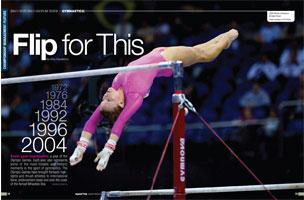
1972 - 1976 - 1984 - 1992 - 1996 - 2004.
Each year represents a year of the Olympic Games. Each year also represents some of the most notable and historic moments in the sport of gymnastics. The Olympic Games have brought fantastic highlights and thrust athletes to international fame, endorsement deals and onto the cover of the famed Wheaties Box.
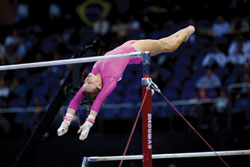 |
| 2009 World Champion Bridget Sloan - Photo courtesy of FIG Photo |
But for gymnastics, its modern day popularity started in 1972 when a 17-year-old Soviet gymnast named Olga Korbut took the world by storm with her daredevil approach to the historically graceful sport. Korbut landed a back flip on the uneven bars that made the world stop and take notice. She walked away with a silver medal for her signature performance and the gold medal in the Beam and Floor exercise.
Korbut's performance put gymnastics in the spotlight, but it was four years later that would catapult it's popularity among young women throughout the world.
Historical Roots
Gymnastics has been around for 2,000 years and like many sports, was dominated by men throughout early history. It was introduced to the United States in 1830; the first Olympic showing was in 1896 with five countries represented.
Like most sports, gymnastics origins can be traced back to ancient Greece as a regimen of military training and conditioning. Gymnastics was also developed as an educational program for children to unite the mind and body.
Women began competing in 1928 and entered Olympic team competitions in 1936. Today, women's competitions dominate the sport with spectators, 69 percent of which are female. This can be attributed in large part to the grace and fluidity of the sport - providing plenty of Kodak moments throughout the sports history.
Silver and Gold
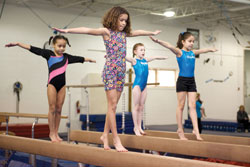 |
| Photo by John Cheng |
The success and popularity of modern day gymnastics can be largely attributed to the Olympic Games since Korbut's history-making performance in 1972.
However, no one could be prepared for what happened just a mere four years later in Montreal. Romanian gymnast Nadia Comaneci was the first to score a perfect 10.0 during the Olympic Games. No male or female gymnast had ever scored a perfect 10 during the Olympics in the games' history.
Steve Penny has been with USA Gymnastics for 10 years, five of those as the president and has seen first hand the effects of the Olympic Games on the popularity of the sport.
"The steepest climb was back 25 years ago when it really took off," said Penny. "We are finding now that it is a steady growth and a positive Olympics (in gymnastics) reinforces that steady growth. The Olympics has also helped the clubs stay in business with the tough economic times."
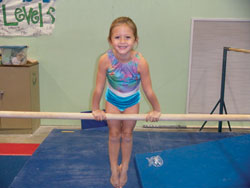 The year 1984 also proved to be a historical year for the United States in gymnastics. The Soviet team boycotted the Olympic Games in Los Angeles and provided a window of opportunity for the U.S. to showcase their talent. With men's stars Bart Conner, Mitch Gaylord and Tim Daggett the team took the gold, and in the women's competition, the world would embrace yet another Olympic favorite.
The year 1984 also proved to be a historical year for the United States in gymnastics. The Soviet team boycotted the Olympic Games in Los Angeles and provided a window of opportunity for the U.S. to showcase their talent. With men's stars Bart Conner, Mitch Gaylord and Tim Daggett the team took the gold, and in the women's competition, the world would embrace yet another Olympic favorite.
Mary Lou Retton became the first American to win the all-around with a perfect 10.0 on the vault and took home the gold. With Retton's contagious smile she immediately became America's sweetheart and the first woman ever to appear on the cover of a Wheatie's Cereal box.
It would be 12 more years before the public embraced another Olympic gymnast to that level. In 1996, Kerri Strug, a member of the Magnificent Seven, appeared to be the U.S. team's last hope at a gold medal in team competition in Atlanta, and with an injured ankle, a premier performance seemed unlikely. But Strug nailed her vault and won the hearts of millions as she was carried off the mat and to the medals podium by Coach Bela Karolyi, former coach to Comaneci in Romania. Strug's performance gave her national fame and a Wheaties box cover as well.
"We definitely see some peaks during the Olympic years," said Carisa Laughon, director of Education Services of USA Gymnastics. "We are membership based and the memberships in general increase during the pre-Olympic and Olympic years because there is more emphasis on the sport and there is more focus on our elite athletes and the training."
The women aren't the only ones to capture the public's heart. In 2004, Paul Hamm pulled out a 'come from behind' performance on the parallel bars and high bar to inch his way to a gold medal in the all-around in Athens. By the slimmest margin possible of .012, Hamm became the first American man to win an Olympic all-around title.
But the most decorated woman gymnast in the history of the United States remains Shannon Miller with seven Olympic medals and nine World Championship all-around titles during the 1992 and 1996 Olympics.
Gymnastics garnered the most hours of NBC Olympic Game coverage in 2004 and was the highest rated night of prime time programming according to the Nielsen television ratings.
Growth and Education
According to the National Federation of State High School Association, 21,178 boys and girls competed at the High School level during the 2008-09 school year. Of those numbers, 18,842 were girls.
As the National Governing Body in the U.S. for gymnastics, USA Gymnastics has seen a dramatic increase in members over the last decade.
Following Comaneci's performance, the number of participants in the sport grew immensely. More than a decade ago, there were approximately 15,000 amateur gymnasts. Today there are a total of 5,273,000 participants in the United States according to USA Gymnastics.
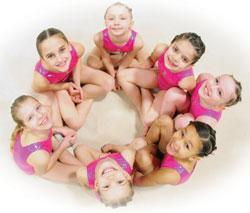 |
| Photo by John Cheng |
"I think you can go back 20-25 years (for major growth)," said Penny. "If you look at what happened after the 1984 Olympics, the sport really spiked in the U.S. That really contributed to the sport of gymnastics at the recreation and professional level and it has grown into an industry. There are 4,000 businesses across the U.S. that supports the gymnastics community. Most of them are clubs, 2,000 of which are members of USA Gymnastics."
The growth of gymnastics can be attributed not only to the showcase of the elite athletes but also to its core values.
"I think the sport is very vibrant at the grass roots level," explained Penny. "The benefit of getting your kids involved goes so far beyond the sport. We are really trying to promote at the basic level that it's fitness for kids. We feel that a gymnastics club is one of the safest and best suited environments for kids to learn how to use their bodies."
With growth comes change. As athletes develop their talent, they also develop new routines challenging their athletic abilities. Likewise, coaches, instructors and judges must evolve to a higher level. USA Gymnastics is committed to providing the necessary tools to their members.
"The challenges that we face now is that gymnastics as a sport has become a technical, almost difficult sport at a high level," said Penny. "It's been challenging to keep it at the high school and college level. The clubs are the some of the best places for elite athletes to train."
Laughon has been working diligently to help tackle these challenges. "We are currently in the process of developing USA Gymnastics University to build educational offering from coaching, as well as a new certification process that will be coming out next year," said Laughon.
In 1998 the organization provided a Safety Risk Management Certification course to the gymnastics community. "We continue to update the course to make sure the education is relevant to athletes and coaches within the sport," explains Laughon. "We offer several other courses online as well to educate coaches, judges, instructors and club owners in the hopes that we can provide education to the gymnastics community, as well as develop a way to evaluate the coaches and instructors and encourage continuing education."
Venues and Events
The DCU Center in Worcester, Massachusetts will host the 2010 Tyson American Cup on March 5th. The Tyson Cup, considered one of the United States' most prestigious international competitions, will be broadcast on NBC in front of an anticipated audience of over 10,000 spectators.
The year 2010 marks the first time Massachusetts will host the Tyson Cup. Destination Worcester, the Massachusetts Sports Authority and DCU Center all worked hard to ensure they were chosen.
"We put together a package that was financially sound and a facility that provided everything for USA Gymnastics and NBC," said Patrick Lynch, executive director of Destination Worcester. "Being 45 minutes outside of Boston offers access to a large fan base and we offer more affordability."
Lynch entered the bidding process with the full support of the community as well, "St. Vincent Hospital came right on board as a sponsor for the medical side of the event and we have been fortunate to have that support from the city. I think all of that together made for a winning bid. It showcases Worcester as a championship destination."
Peoria, Illinois is hosting the 19th Annual St. Jude Benefit Meet, a USA Gymnastics sanctioned meet, in January 2010.
"This event has always been held in Peoria," said Chevie Ruder, event organizer and Sports and Convention Services manager for the Peoria Area Convention & Visitors Bureau. The event will bring 1,000 gymnasts, 200 events and close to 500 room nights over a two-day period.
"Being that the event is held on Martin Luther King weekend it works out great," explains Ruder. "People can stay and sightsee and do other activities while they are here and extend their vacation."
For the area, this event has helped us achieve a Level 5 State meet and a Level 8 Regional meet for Region Five (Michigan, Indiana, Illinois, Ohio and Kentucky)," she continued. "In the past year, Peoria alone has added two more gymnastic events."
Ruder speaks first hand of the benefits to not only the Peoria area, but also to St. Jude's. Ruder was a former competitor in the St. Jude Benefit Meet for three years.
"All the money goes directly to St. Jude," explains Ruder. "Not only are we attracting people to the area, but also raising awareness and educating children about St. Jude Hospital so that when they grow up they realize the value of the event."
What's New?
With competition comes controversy and gymnastics is not immune. During the 2006 Olympics there was plenty of fodder over the age requirements by some members of the Chinese team. Following an investigation by the International Olympic Committee, the accusations were unfounded and the Chinese women's team went on to win.
The controversy ignited debates on the development and safety of young gymnasts, but the news on the horizon is good according to Penny.
"I think in America especially, the entire gymnastics community is dedicated to a safe environment," he explained. "The people that are doing it right know that safety is the number one commitment. We (USA Gymnastics) are very committed to that as well. It's not as much a function of age as much as capability of the athlete. Our mentality is that the sport is about athletic ability and what a kid can do with the right instruction and equipment."
"The goal is to bring an athlete to their highest level of ability in the safest environment," said Penny. "Sometimes, they will get there at 14, 16 or 18 and you make sure you provide the right amount of instruction."
Certainly the support from the gymnastics community has helped propel the popularity of gymnastics and will continue to do so for years to come.

